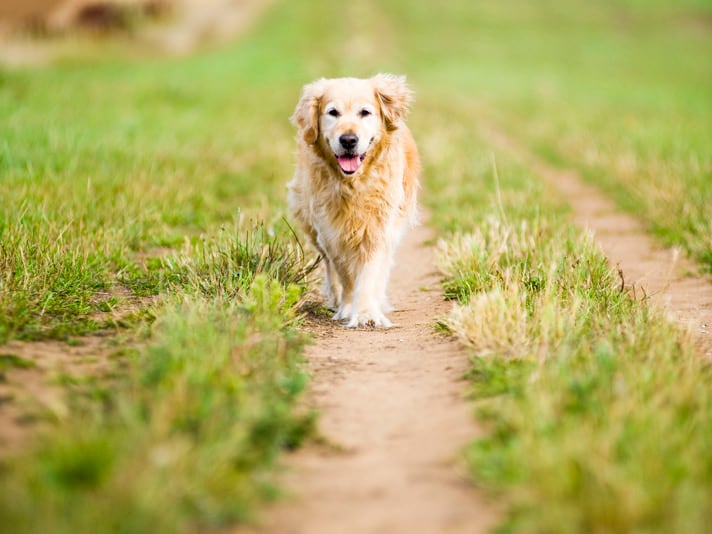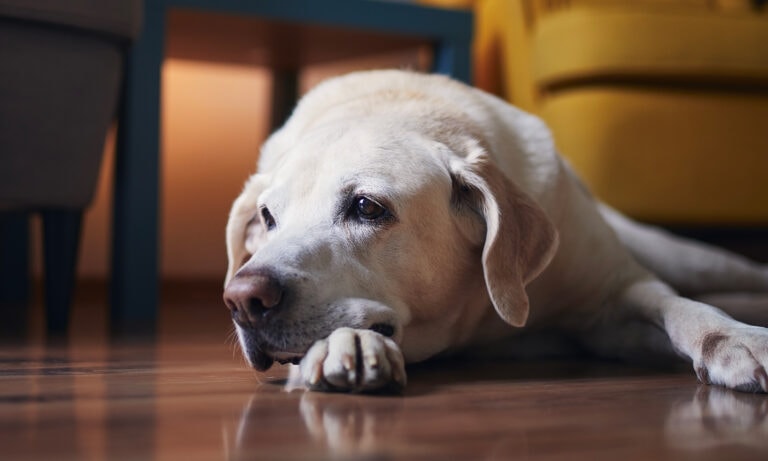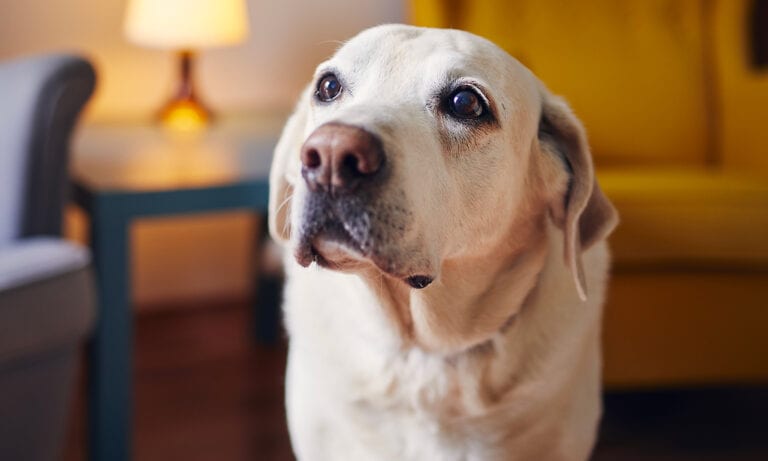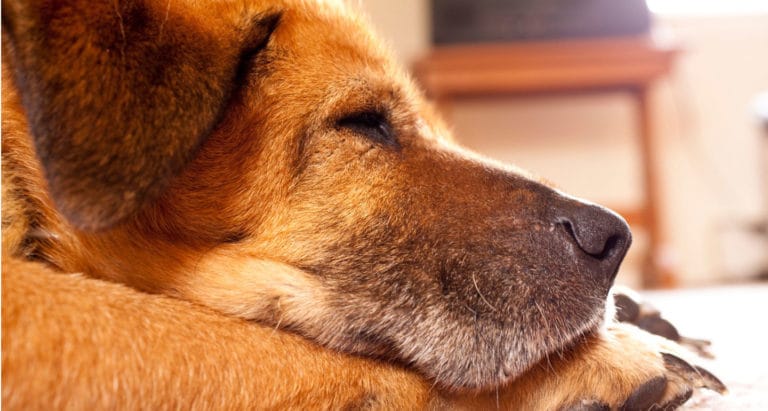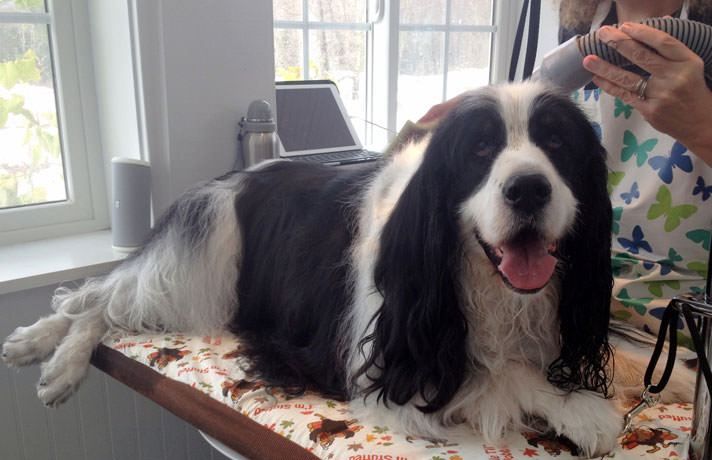As a puppy, my now-senior dog named Pete had more energy than he (or I!) knew what to do with. Romping and rolling, sniffing and chewing, digging and exploring, my mixed breed paused only to eat, snooze and cuddle. He was a handful, that little pup.
Nine eventful years later, Pete has slowed down a bit. He’s still healthy and strong, but he’s not as energetic as he once was. He strolls to the garden. He meanders down the hiking trails. He enjoys extra long naps on his memory foam dog bed. And he plays fetch on his terms — when he’s done, he drops his ball in his dog toy box, lies down on the lawn and soaks up the joint-soothing sunshine.
Even at his age, exercise is important, says Ernie Ward, DVM, founder of the Association for Pet Obesity Prevention. But what makes it fun is doing it together. “Dogs crave our interaction and want to connect with us emotionally and spiritually,” Ward says. “Part of that connection can only be made through physical activity. So walking your dog is really about so much more than them going to potty or losing a couple of pounds. It’s about supporting this deep connection.”
Good For What Ails You
Like humans, all dogs — even seniors — need exercise. Physical activity keeps our bones strong. It maintains muscular and connective tissues. It creates a sharp brain, a strong heart and sturdy lungs. It also helps us sleep better, feel better and enjoy life better. “We often tend to think of exercise only in terms of maintaining weight or keeping a certain body condition,” Ward says. “But the reality is that exercise can do so much more.
One of the hidden benefits of exercise for dogs is helping with behavior. Any time you see a dog with separation anxiety, the ones who bark or yowl or chew up the carpet when they’re left alone, that’s usually a cry for more aerobic activity.”
Exercise really does benefit your dog in many ways, including:
- Controlling weight
- Combating health conditions and diseases
- Improving mood and behavior
- Boosting energy
- Promoting sleep
- Strengthening the bond between you and your pet
Silver Muzzle Club
Depending on the breed, a dog is considered a senior when he’s 7 to 10 years old. That’s when his muzzle starts to gray, he loses strength and flexibility, his health starts to falter and his energy level drops. The dog’s biological clock is ticking, but he’s still able to enjoy life with his humans.
To stay healthy and happy throughout his senior years, your dog needs regular, structured exercise that’s appropriate for his age and abilities, Ward says. “When dogs start to get to 7, 8, 9, 10 years old, they naturally slow down,” he says. “And so we shift the exercise emphasis to low-intensity activity. We stop doing agility and Frisbee catching and jumping up in the air, and we start to do more hiking and strolling and swimming type of activities.”
A regular exercise routine will keep your senior dog mobile and stimulated, and it can help ease the symptoms of existing or developing medical problems, including obesity, Type 2 diabetes, respiratory and heart disease, osteoarthritis, high blood pressure and cancer, Ward says.
An older dog may have a slowly diminishing ability to exercise vigorously like he did when he was a puppy and adult, but he should demonstrate an active interest in his daily routine and tolerate moderate exercise. If your dog shows any abrupt behavior changes or has difficulty exercising, take him to your veterinarian.
Continuing A Lifelong Habit
So how do you exercise a senior dog? Mindfully — but remember that age is just a number, Ward says. If your senior dog is healthy and spry, go for a hike or swim with him. If he’s living with sore joints from arthritis, short walks might be best.
“Don’t let a date on a calendar be your excuse or limiting factor,” Ward says. “Age is not the key determinant. There’s so much more to health and fitness.” For exercising senior dogs, Ward generally recommends straight-line movements as opposed to the dynamic movements in agility, fetch or Frisbee. “When they’re 8, 10 years old, you may want to avoid high-intensity, high-impact activities,” he says. “Leaping and jumping is where we’re going to get in trouble.
Quick stops and starts and turns is where we’re going to buckle that knee or damage that shoulder. I encourage straight-line work, activities that keep the dog moving in one direction.” As with adult dogs and puppies, try to exercise your senior dog for 30 minutes each day, depending on his abilities, Ward says. “You don’t have to do it all at once; you can get in 10 minutes in the morning, 15 minutes in the evening and 10 minutes before bed, for example, and you’ll be well on your way to better health,” he says.
Whichever activity you choose, stroll on soft surfaces like grass, Ward says. It’s easier on the joints. “As for surfaces, soft grass, meadows and parks are my preferred substrate for exercise,” he says. “Asphalt would be my second choice. It’s better than concrete, which can be really tough on joints. And be cautious of playing in loose sand; hard-packed shore break sand is OK, but if you’re in loose sand, you’re at much greater risk of injuring your dog’s knees, hips, shoulders and elbows.”
Enjoying The Golden Years
He may sleep longer and move more slowly than he did when he was a pup, but Pete still loves a long jaunt through the woods, even if he isn’t chasing a squirrel or tracking a raccoon’s scent. I’ll keep encouraging that exercise — but pay close attention to his behavior. If it changes, we’ll adjust his workout program.
By: Wendy Bedwell-Wilson
Featured Image: Matthew Williams-Ellis/iStock/Thinkstock
Share:
